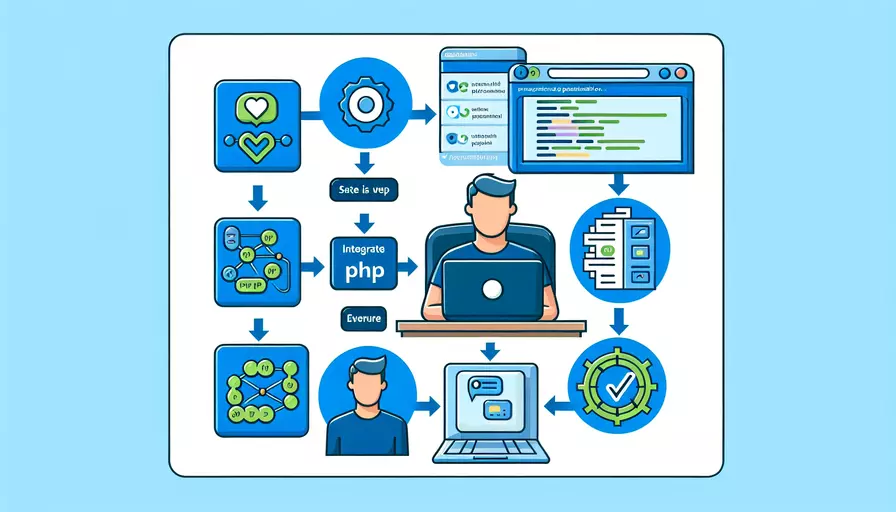
在Vue中使用PHP可以通过以下方式进行:1、使用PHP作为后端服务器,提供API接口,2、在Vue项目中发起HTTP请求,3、使用PHP渲染Vue组件,4、在同一个项目中混合使用PHP和Vue。这些方法可以帮助开发者将Vue的前端功能与PHP的后端功能结合起来,创建功能强大的Web应用。
一、使用PHP作为后端服务器,提供API接口
将PHP作为后端服务器,提供API接口供Vue前端调用是一种常见的方式。以下是具体步骤:
-
创建PHP API:
- 编写PHP脚本,连接数据库并处理请求。
- 例如,可以创建一个
api.php文件,用于处理客户端的GET和POST请求。
<?phpheader('Content-Type: application/json');
$conn = new mysqli('localhost', 'username', 'password', 'database');
if ($conn->connect_error) {
die("Connection failed: " . $conn->connect_error);
}
$method = $_SERVER['REQUEST_METHOD'];
if ($method == 'GET') {
$result = $conn->query('SELECT * FROM users');
$users = $result->fetch_all(MYSQLI_ASSOC);
echo json_encode($users);
} elseif ($method == 'POST') {
$data = json_decode(file_get_contents('php://input'), true);
$stmt = $conn->prepare('INSERT INTO users (name, email) VALUES (?, ?)');
$stmt->bind_param('ss', $data['name'], $data['email']);
$stmt->execute();
echo json_encode(['id' => $stmt->insert_id]);
}
$conn->close();
?>
-
在Vue中发起HTTP请求:
- 使用
axios或fetch来发起HTTP请求,调用PHP API。 - 首先,安装
axios:
npm install axios- 然后,在Vue组件中使用
axios发起请求:
<template><div>
<ul>
<li v-for="user in users" :key="user.id">{{ user.name }} - {{ user.email }}</li>
</ul>
<form @submit.prevent="addUser">
<input v-model="newUser.name" placeholder="Name" />
<input v-model="newUser.email" placeholder="Email" />
<button type="submit">Add User</button>
</form>
</div>
</template>
<script>
import axios from 'axios';
export default {
data() {
return {
users: [],
newUser: { name: '', email: '' }
};
},
created() {
this.fetchUsers();
},
methods: {
fetchUsers() {
axios.get('http://your-server/api.php')
.then(response => {
this.users = response.data;
});
},
addUser() {
axios.post('http://your-server/api.php', this.newUser)
.then(response => {
this.users.push({ ...this.newUser, id: response.data.id });
this.newUser = { name: '', email: '' };
});
}
}
};
</script>
- 使用
二、在Vue项目中发起HTTP请求
在Vue项目中,可以通过axios或fetch来发起HTTP请求,调用PHP后台API:
-
安装
axios:- 使用npm安装
axios:
npm install axios - 使用npm安装
-
创建Vue组件,使用
axios进行数据请求:<template><div>
<h1>Users</h1>
<ul>
<li v-for="user in users" :key="user.id">{{ user.name }} - {{ user.email }}</li>
</ul>
</div>
</template>
<script>
import axios from 'axios';
export default {
data() {
return {
users: []
};
},
created() {
this.fetchUsers();
},
methods: {
fetchUsers() {
axios.get('http://your-server/api.php')
.then(response => {
this.users = response.data;
});
}
}
};
</script>
三、使用PHP渲染Vue组件
在某些情况下,可以使用PHP渲染Vue组件,尤其在需要服务器端渲染时:
-
设置PHP后端:
- 在PHP文件中嵌入Vue组件代码:
<!DOCTYPE html><html>
<head>
<title>Vue with PHP</title>
<script src="https://cdn.jsdelivr.net/npm/vue@2"></script>
</head>
<body>
<div id="app">
<user-list></user-list>
</div>
<script>
Vue.component('user-list', {
data: function() {
return {
users: <?php echo json_encode($users); ?>
};
},
template: `
<ul>
<li v-for="user in users">{{ user.name }} - {{ user.email }}</li>
</ul>
`
});
new Vue({
el: '#app'
});
</script>
</body>
</html>
-
获取数据并渲染:
- 在PHP中获取数据并将其传递给Vue组件:
<?php$conn = new mysqli('localhost', 'username', 'password', 'database');
if ($conn->connect_error) {
die("Connection failed: " . $conn->connect_error);
}
$result = $conn->query('SELECT * FROM users');
$users = $result->fetch_all(MYSQLI_ASSOC);
?>
<!DOCTYPE html>
<html>
<head>
<title>Vue with PHP</title>
<script src="https://cdn.jsdelivr.net/npm/vue@2"></script>
</head>
<body>
<div id="app">
<user-list></user-list>
</div>
<script>
Vue.component('user-list', {
data: function() {
return {
users: <?php echo json_encode($users); ?>
};
},
template: `
<ul>
<li v-for="user in users">{{ user.name }} - {{ user.email }}</li>
</ul>
`
});
new Vue({
el: '#app'
});
</script>
</body>
</html>
四、在同一个项目中混合使用PHP和Vue
有时,开发者可能希望在同一个项目中混合使用PHP和Vue:
-
项目结构:
- 将PHP文件放在
backend文件夹中,将Vue项目放在frontend文件夹中。 - 例如:
project/├── backend/
│ ├── api.php
│ └── other-php-files.php
└── frontend/
├── src/
│ └── components/
│ └── UserList.vue
├── public/
│ └── index.html
└── package.json
- 将PHP文件放在
-
设置前后端通信:
- 在Vue组件中,通过HTTP请求与PHP后端通信。
<template><div>
<h1>Users</h1>
<ul>
<li v-for="user in users" :key="user.id">{{ user.name }} - {{ user.email }}</li>
</ul>
</div>
</template>
<script>
import axios from 'axios';
export default {
data() {
return {
users: []
};
},
created() {
this.fetchUsers();
},
methods: {
fetchUsers() {
axios.get('http://your-server/backend/api.php')
.then(response => {
this.users = response.data;
});
}
}
};
</script>
总结起来,在Vue中使用PHP主要有四种方法:1、使用PHP作为后端服务器,提供API接口;2、在Vue项目中发起HTTP请求;3、使用PHP渲染Vue组件;4、在同一个项目中混合使用PHP和Vue。根据具体需求选择合适的方法,可以有效地将Vue与PHP结合,构建功能强大的Web应用。
相关问答FAQs:
1. Vue中如何使用PHP?
在Vue中使用PHP主要是通过发送HTTP请求与后端进行通信。Vue可以通过axios、fetch等库发送请求,而PHP则可以通过接收请求、处理数据、返回响应等方式与前端进行交互。
首先,你需要在Vue项目中安装axios或其他类似的库。你可以使用npm或yarn命令来安装它们。例如,通过运行以下命令安装axios:
npm install axios --save
安装完成后,你需要在Vue组件中引入axios,如下所示:
import axios from 'axios';
接下来,你可以在Vue组件中使用axios发送HTTP请求。以下是一个简单的示例,展示了如何发送GET请求并处理返回的数据:
axios.get('/api/data.php')
.then(response => {
// 处理返回的数据
console.log(response.data);
})
.catch(error => {
// 处理请求错误
console.log(error);
});
在上述示例中,我们发送了一个GET请求到/api/data.php,并使用.then方法来处理返回的数据,使用.catch方法来处理请求错误。你可以根据需要进行适当的处理。
另外,你还可以发送其他类型的HTTP请求,如POST、PUT、DELETE等。以下是一个示例,展示了如何发送POST请求并传递数据:
axios.post('/api/submit.php', {
name: 'John',
age: 25
})
.then(response => {
// 处理返回的数据
console.log(response.data);
})
.catch(error => {
// 处理请求错误
console.log(error);
});
在上述示例中,我们发送了一个POST请求到/api/submit.php,并传递了一个包含name和age属性的数据对象。
总结起来,通过使用axios或其他类似的库,你可以在Vue中与PHP进行通信。你可以发送不同类型的HTTP请求,并处理返回的数据或请求错误。这种方式使得前端与后端的交互更加灵活和方便。
2. Vue中如何将PHP数据渲染到页面上?
要将PHP数据渲染到Vue页面上,你可以通过发送HTTP请求获取PHP返回的数据,并将其绑定到Vue组件的数据属性上。然后,你可以在Vue模板中使用这些数据来展示在页面上。
首先,你需要在Vue组件中使用axios或其他类似的库发送HTTP请求,获取PHP返回的数据。以下是一个示例,展示了如何发送GET请求并将返回的数据绑定到Vue组件的data属性上:
import axios from 'axios';
export default {
data() {
return {
userData: []
}
},
mounted() {
axios.get('/api/user.php')
.then(response => {
// 将返回的数据绑定到data属性上
this.userData = response.data;
})
.catch(error => {
console.log(error);
});
}
}
在上述示例中,我们发送了一个GET请求到/api/user.php,并将返回的数据绑定到组件的userData属性上。当数据获取成功后,Vue会自动更新页面上绑定的数据。
接下来,在Vue模板中使用这些数据来展示在页面上。以下是一个示例,展示了如何使用v-for指令遍历userData数组,并展示每个用户的姓名和年龄:
<template>
<div>
<h2>User List</h2>
<ul>
<li v-for="user in userData" :key="user.id">
{{ user.name }} - {{ user.age }}
</li>
</ul>
</div>
</template>
在上述示例中,我们使用了v-for指令来遍历userData数组,并使用插值语法{{ }}来展示每个用户的姓名和年龄。
通过以上步骤,你可以将PHP数据渲染到Vue页面上。发送HTTP请求获取数据,并将其绑定到Vue组件的data属性上,然后在模板中使用这些数据展示在页面上。
3. Vue中如何将用户输入的数据发送到PHP后端进行处理?
要将用户输入的数据发送到PHP后端进行处理,你可以通过发送HTTP请求将数据传递给PHP脚本,并在PHP中进行相应的处理。Vue可以使用axios或其他类似的库发送HTTP请求,而PHP可以通过接收请求、获取用户输入的数据、处理数据等方式与前端进行交互。
首先,你需要在Vue组件中获取用户输入的数据。可以使用Vue的v-model指令将用户输入的数据绑定到Vue组件的data属性上。以下是一个示例,展示了如何获取用户输入的用户名和密码:
<template>
<div>
<input v-model="username" type="text" placeholder="Username">
<input v-model="password" type="password" placeholder="Password">
<button @click="submit">Submit</button>
</div>
</template>
<script>
import axios from 'axios';
export default {
data() {
return {
username: '',
password: ''
}
},
methods: {
submit() {
// 将用户输入的数据发送到PHP后端
axios.post('/api/login.php', {
username: this.username,
password: this.password
})
.then(response => {
// 处理返回的数据
console.log(response.data);
})
.catch(error => {
// 处理请求错误
console.log(error);
});
}
}
}
</script>
在上述示例中,我们使用了Vue的v-model指令将用户输入的用户名和密码绑定到Vue组件的data属性上。当用户点击“Submit”按钮时,会调用submit方法,将用户输入的数据通过POST请求发送到/api/login.php。
接下来,在PHP脚本中接收请求,并获取用户输入的数据。你可以使用$_POST或其他类似的变量来获取POST请求中的数据。以下是一个示例,展示了如何获取用户输入的用户名和密码:
$username = $_POST['username'];
$password = $_POST['password'];
// 进行相应的处理
// ...
在上述示例中,我们通过$_POST变量获取了用户输入的用户名和密码,并可以在PHP中进行相应的处理。
通过以上步骤,你可以将用户输入的数据发送到PHP后端进行处理。在Vue组件中获取用户输入的数据,并通过发送HTTP请求将数据传递给PHP脚本,在PHP中获取数据并进行相应的处理。这样,你就可以实现前后端的数据交互和处理。
文章标题:vue中如何使用php,发布者:不及物动词,转载请注明出处:https://worktile.com/kb/p/3620265

 微信扫一扫
微信扫一扫  支付宝扫一扫
支付宝扫一扫 